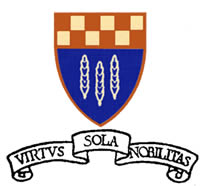


References
This Section lists the principal “generally available” information sources used in the compilation of the School’s History. More specialist information is available through the Nottingham City Local Studies Library and local museums and archives.
GENERAL HISTORIES
High Pavement Remembered, 1788-
Edited by Alan Bates, 1988: An A5-
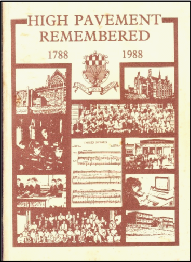 The Back Cover carries the inscription:
The Back Cover carries the inscription:
“1788-
“This volume commemorates the Bicentenary of High Pavement and offers a celebration in print of the long history of one of Nottingham’s best known educational establishments.”
Specially written by the staff of the College to commemorate the Bicentenary it is probably the best single document covering the History of High Pavement. It is structured in 2-
1. High Pavement Through the Years: describes the history of the school
2. High Pavement Remembered: reminiscences of life at the school over the years – obtained from a wide range of sources
Sadly, the book is thin on material about the Gainsford Crescent years and does not give full credit to the staff who made major contributions in those years. Sadly also. this book has been out of print for many years now and copies are hard to find.
Victorian Nottingham – A Story in Pictures – Vol 20
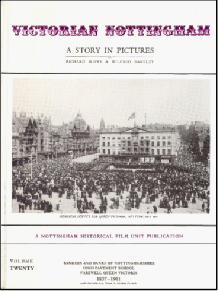 Sub-
Sub-
Published by the Nottingham Historical Film Unit, 7 The Crescent, Woodthorpe, Nottingham NG5 4FX. © 1983 Richard Iliffe & Wilfred Baguley. A4-
Part 2 “High Pavement School”, Pages 38-
Old Nottingham
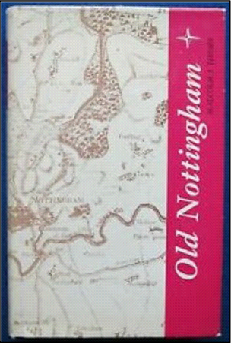 By Malcolm L Thomis, 1968. Contains Chapter “High Pavement: a Chapel and a School”. Published in 1968 by David & Charles Ltd, South Devon House, Railway Station, Newton Abbot, Devon.
By Malcolm L Thomis, 1968. Contains Chapter “High Pavement: a Chapel and a School”. Published in 1968 by David & Charles Ltd, South Devon House, Railway Station, Newton Abbot, Devon.
Chapter 7, “High Pavement; a chapel and a school”(P97-
P113 states “in 1880, a special science department was set up which has often been claimed, quite mistakenly, as the first science teaching school department in the country.” although he gives no evidence to support this statement. However, this Book was printed in 1968 whereas the research that proved that High Pavement was the first Organised Science School was not conducted until 1989-
Education and Society in Nineteenth Century Nottingham
By David Wardle, Head of Education Department, Padgate College of Education, 1971. Published by Cambridge University Press. First published 1971, First Paperback printing 2010. ISBN-
In its original form, this work was presented as a PhD thesis to Nottingham University. This work includes many references to High Pavement School.
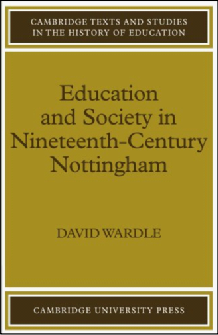 Contents
Contents
Map of Nottingham in about 1800
Introduction 1
1. The Industrial Revolution 4
2. Nottingham in the Early Nineteenth Century 18
3. The Provision of Voluntary Schools 37
4. The Work of the Voluntary Schools 57
5. Elementary Education under the school Board 82
6. Secondary, Technical and Higher Education 117
7. Private Schools 147
8. Adult Education 170
9. Bibliography 197
10. Index 203
Official Opening of the Gainsford Crescent School, 1955
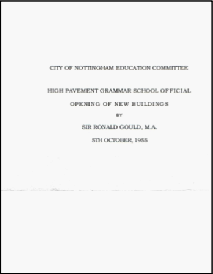 “High Pavement Grammar School Official Opening Of New Buildings”, By Sir Ronald Gould, M.A. 5th October, 1955. [12 Pages, A4].
“High Pavement Grammar School Official Opening Of New Buildings”, By Sir Ronald Gould, M.A. 5th October, 1955. [12 Pages, A4].
Includes a concise history of High Pavement School, a history of the development of the new Gainsford Crescent site and detailed ground plans of the new buildings. Also includes a list of ALL previous Headmasters (with years), a list of the School Governors for years 1954/5 & 1955/6, a list of the members of the Education Committee 1955/6 and 9 photographs.
Click on Picture for a pdf of the document.
REMEMBRANCE
World War 1 -
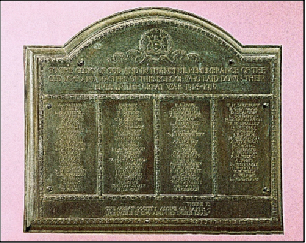 This bronze Memorial Plaque is currently located in the Entrance Hall of the High Pavement Sixth-
This bronze Memorial Plaque is currently located in the Entrance Hall of the High Pavement Sixth-
This Memorial Plaque was first unveiled in the Main Hall of the Stanley Road School in 1920. The Plaque bears the names of 93 former members of the school who lost their lives in the First World War. It carried the inscription “TO THE GLORY OF GOD AND IN THANKFUL REMEMBRANCE OF THE OLD BOYS AND MASTERS WHO LAID DOWN THEIR LIVES IN THE GREAT WAR 1914-
In 1955, High Pavement School relocated to new premises in Gainsford Crescent, Bestwood Estate and this plaque was moved with the School and remounted in the Entrance Hall there. It remained there for the next 40 years and through the years of the conversion to a 6th-
In 2002, the High Pavement Sixth-
Notts County Council -
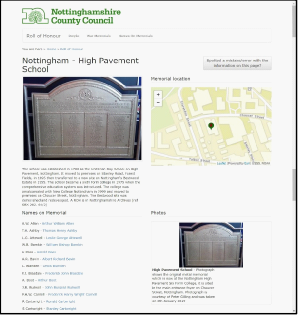 As Part of the Great War Centenary events, the Nottinghamshire County Council established an On-
As Part of the Great War Centenary events, the Nottinghamshire County Council established an On-
The Home page can be found at:
Nottinghamshire Great War Roll of Honour
and the specific page referencing the High Pavement School Memorial can be found at:
Nottingham -
This page gives access to the full list of the Fallen and much information about each (including their first names and ages) extracted from Peter Foster’s Book “We Will Remember Them: The Fallen of High Pavement School, Nottingham, 1914-
We Will Remember Them
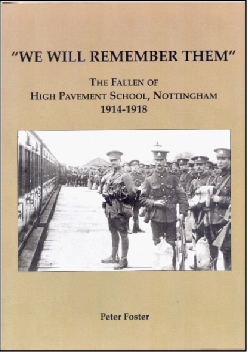 “We Will Remember Them: The Fallen of High Pavement School, Nottingham, 1914-
“We Will Remember Them: The Fallen of High Pavement School, Nottingham, 1914-
The book begins by describing, as background, the principal theatres of war. It then goes on to consider in turn the 93 Names in the School’s “World War 1 War Memorial” plus 1 additional name identified by the author’s research. For each of the Fallen in turn, the book describes their home and family background, their days at School, their civilian life and career and their service in the armed forces leading up to their untimely deaths. The author, Peter Foster, is himself a former pupil of High Pavement School.
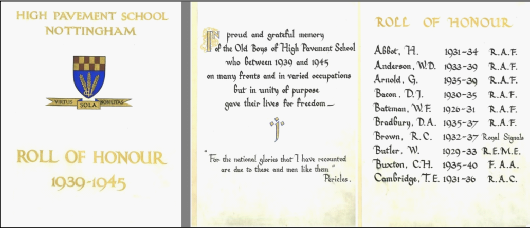
World War 2 – Book of Remembrance
The School’s memorial to the Fallen of the 2nd World War takes the form of a “Book of Remembrance”. This Book is currently held in the Information Centre of the High Pavement Sixth-
Compared with the First World War Bronze Memorial Plaque this is a more modest memorial but probably more affordable at the time. The 2nd World War was followed by several years of severe austerity (with food rationing not ending until 1954 and coal until 1958) whereas the 1st World War had been followed by a period of some prosperity. The original intention had been to employ the calligraphy skills of the School in the creation of this Book and to eventually display the Book in a velvet-
They Shall Not Grow Old
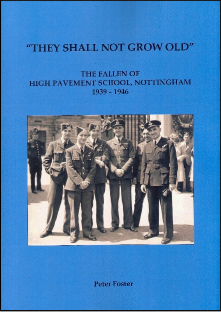 “They Shall Not Grow Old: The Fallen of High Pavement School, Nottingham 1939-
“They Shall Not Grow Old: The Fallen of High Pavement School, Nottingham 1939-
The book is a companion to Peter’s earlier book “We Will Remember Them” in which he records the High Pavement fallen of the 1st World War. It begins by describing, as background, the principal theatres of the 2nd World War and then goes on to consider in turn the 90 Names in the School’s “World War 2 Book of Remembrance”. In also considers 4 additional names identified by the author’s research. For each of the fallen in turn, the book describes their home and family background, their days at School, their civilian life and career and their service in the armed forces leading up to their untimely deaths. The author, Peter Foster, is himself a former pupil of High Pavement School.
RESEARCH TOPICS
1. Non-
“Victorian Nottingham – A Story in Pictures – Vol 20” by Richard Iliffe & Wilfred Baguley (listed above). The “Non-
2. Organised Science School
High Pavement: Britain's First Organised Science School
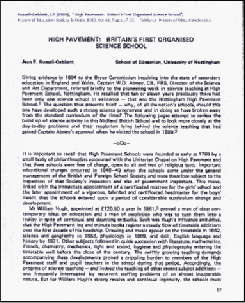 Russell-
Russell-
This Paper includes the key extract from the “Bryce Commission (Royal Commission on Secondary Education) 1894-
“Giving evidence in 1894 to the Bryce Commission inquiring into the state of secondary education in England and Wales, Captain W.D. Abney, CB, FRS, Director of the Science and Art Department, referred briefly to the pioneering work in science teaching at High Pavement School, Nottingham. He recalled that ten or eleven years previously there had been only one science school in existence – that was the Nottingham High Pavement School.”
High Pavement School Science 1885-
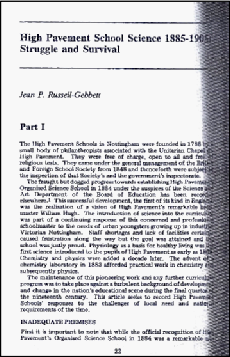 Russell-
Russell-
High Pavement School Science 1885-
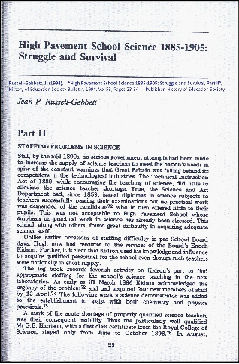 Russell-
Russell-
Moralising and ‘Dirty Fingers’: Nineteenth Century Science Textbooks in two Nottingham Schools.
Russell-
This Paper compares the teaching of Science in High Pavement School with that in the Nottingham Blue-
3. State-
The first County school?
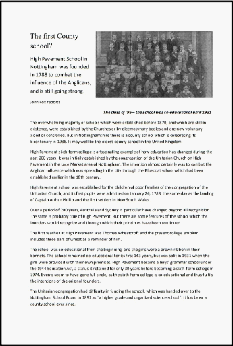 “The first County school?”, by John Fox (Former Chief Education Officer for Nottinghamshire). Times Educational Supplement dated 27.5.1988.
“The first County school?”, by John Fox (Former Chief Education Officer for Nottinghamshire). Times Educational Supplement dated 27.5.1988.
This article was written on the occasion of the High Pavement School’s Bicentenary in 1988.
Click on Picture for a pdf of the document
4. Women’s Education
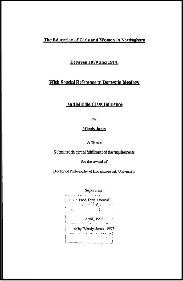 Education of Girls and Women in Nottingham Between 1870 and 1914
Education of Girls and Women in Nottingham Between 1870 and 1914
Jones, Wendy. 1998. “The Education of Girls and Women in Nottingham Between 1870 and 1914: With Special Reference to Domestic Ideology and Middle Class Influence”. [404 Pages, A4]
A Thesis submitted in partial fulfilment of the requirements for the award of Doctor of Philosophy of Loughborough University. Supervisor: Prof. John Thomas, April, 1998. © by Wendy Jones 1997.
A copy of document can be downloaded from:
CONTENTS
Acknowledgements
CHAPTER I: The Development of Education After 1870 With Particular Reference to Nottingham 1
CHAPTER II: Issues in the History of Women's Education 33
CASE STUDY: NOTTINGHAM
CHAPTER Ill: The City of Nottingham 83
CHAPTER IV: Academic Subjects in the Curriculum 92
CHAPTER V: Religion, Games and Exercise 1 07
CHAPTER VI: Craft Subjects: Needlework 120
CHAPTER VII: Craft Subjects: Domestic Economy, Cookery and Laundry 139
CHAPTER VIII: Craft Subjects: Housewifery, Babycare and Manual Instruction 172
CHAPTER IX: Problems of Access, Attendance, Absence and Punishment 189
CHAPTER X: Further Aspects of Elementary Education 222
CHAPTER XI: Half Timers, School Leavers, Industrial Schools, the Workhouse and Ragged Schools 235
CHAPTER XII: Higher Grade Schools 255
CHAPTER XIII: Pupil Teachers and Teachers 264
CHAPTER XIV: Adult Education 284
CHAPTER XV: Higher Education 301
CHAPTER XVI: Middle Class Influence in Education 324
CHAPTER XVII: Informal Education 342
CHAPTER XVIII: Private Education 350
CHAPTER XIX: CONCLUSION 383
BIBLIOGRAPHY (including interviews with local residents)· 387
5. Engineering Courses
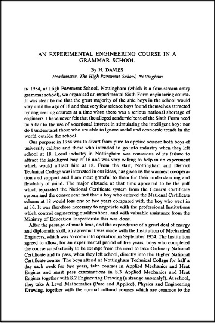 An experimental engineering course in a grammar school
An experimental engineering course in a grammar school
H. Davies (1959) “An experimental engineering course in a grammar school”, The Vocational Aspect of Secondary and Further Education, 11:22, 28-
A copy of the document can be found at:
Other Documents
Culture and the Grammar School
 By Davies, Harry 1965 “Culture and the Grammar School”, 1 ed, Copyright Year 1965, ISBN 9781138221154, Published 25 Sep 2018 by Routledge [192 Pages, Soft-
By Davies, Harry 1965 “Culture and the Grammar School”, 1 ed, Copyright Year 1965, ISBN 9781138221154, Published 25 Sep 2018 by Routledge [192 Pages, Soft-
The book is described by the Publishers as follows: “This book, first published in 1965, discusses the nature of the grammar school, its curriculum and teaching methods, comparisons with sixth form education, and the change in its organisation and attitudes during a time of rapid social change in 1960s Britain. This title will be of interest to students of history, sociology and education.”
Prof Davies was clearly aware of the particular difficulties faced by those pupils who were first in the family to go to a Grammar School in coming to terms with the Grammar School ethos and lifestyle. Those with an older sibling at the Grammar School fitted in more smoothly.
The HISTORIANS
The above documents owe much to the research of a number of “real” historians who have diligently researched the history of the School in depth and whose work has been documented and appeared in print:
Keith S.S. TRAIN: Keith was on the staff of the School for some 39 years, from 1927-
Malcolm THOMIS: Malcolm was on the staff of the School from 1960-
David WARDLE: In 1971 he was Head of the Education Department, Padgate College of Education.
Geoffrey OLDFIELD: A well known Nottingham Local History author, Geoffrey also an Old Pavior and a long-
Mrs Jean P RUSSELL-